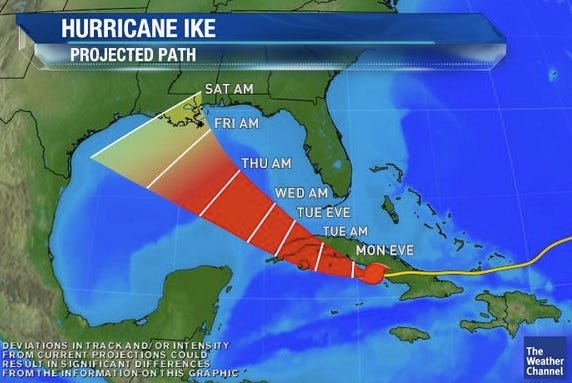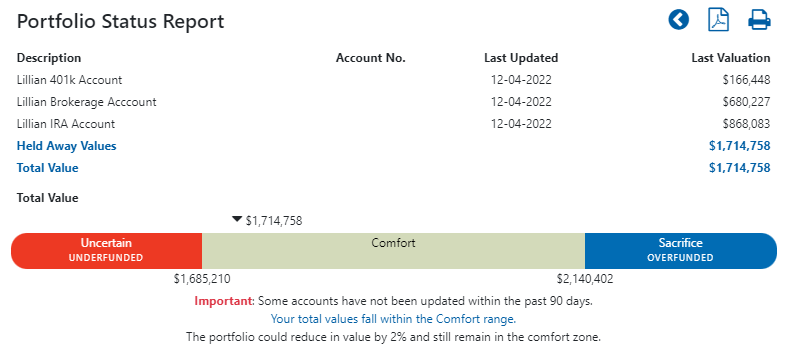Hope you’re ready for a wonderful Wednesday!
On Thursday of last week, around 8am or so, I checked the weather app on my phone.
There was rain in the forecast for later in the day, but none for the next 3-4 hours.
The radar was completely clear, and there was no rain headed my way in the next hour.
So I took our dog, Winnie, for a walk.
You can probably guess what happened…
At pretty much the furthest point from our home before we started to head back, the skies opened up. 🌧
We got completely soaked.
I think Winnie is still angry with me!
And while I wasn’t happy to get drenched - and may have uttered an expletive or two - I wasn’t entirely surprised that the forecast proved to be inaccurate.
Because meterologists can’t see the future.
Neither can financial advisors, fortune tellers, money managers, Jim Cramer, or anyone else.
Is my weather app to blame?
Is a different, better weather app the solution?
My weather app gets great ratings and rave reviews in the iOS app store. But it can’t see the future either.
When it comes to weather apps, popularity doesn’t necessarily equal accuracy.
Here’s an interesting website you might want to check out: ForecastAdvisor.com
Click that link and enter your zip code and it will show you which weather services/apps have been the most accurate for the last month and the last year in your area.
The link above is for my home zip code in Atlanta and it shows that the “best” weather forecast is only accurate about 80% of the time.
Which, of course, means it’s wrong 20% of the time, or about 1 out of 5 times.
Are those good odds?
I’m not sure.
I guess “good” is pretty subjective when it comes to a weather forecast.
But what about a weather forecast when you introduce the element of time?
If you have a 7-day forecast, are you as confident in the forecast on day seven as the forecast 12 hours from now?
I’m not.
And clearly the forecast even just 1 hour from now isn’t always going to be right.
The Cone of Uncertainty
If you’ve ever paid attention to a tropical storm or hurricane forecast, you’ve probably seen an image like the one above. It’s a forecast.
Notice how the “cone” gets wider the further into the future we go?
And how it’s relatively narrow over the next 24-48 hours?
This is because when it comes to the weather, more time introduces less accuracy.
More time introduces a wider array of potential outcomes.
And that’s what the graphic above captures.
But even a short-term weather forecast isn’t guaranteed. I experienced this first hand on my rain-soaked walk with Winnie last week.
But how might this apply to your portfolio?
Or your financial plan?
When it comes to your investment portfolio, the “cone of uncertainty” actually gets flipped around.
The cone is much wider over the coming days, weeks, and months and gets more narrow over longer time periods such as decades.
But this is only true if you can stick with your investments - hopefully a broadly diversified portfolio - over long periods of time.
Otherwise, you’re just jumping from one “wide cone of uncertainty” to the next again and again.
But over decades, investments tend to move toward their long-term average returns.
Be warned, however, not to assume the long-term average return will happen over shorter time frames.
It very rarely does as this graph demonstrates:

It’s OK to be disappointed by short-term market swings, but you should never be surprised by them.
Jim Cramer is a popular TV personality who shouts his investment forecasts alongside sound effects and highly produced graphics on CNBC. But just like my popular weather app can’t see the future, neither can Mr. Cramer as evidenced by his poor track record.
When it comes to financial forecasts, popularity doesn’t necessarily equal accuracy.
And historical long-term average investment returns - described above - aren’t a forecast either. It’s just history, which isn’t a a good indication of future results. But it can be a helpful guide if used judiciously.
Personally, I think all investment & financial forecasts are worthless. I don’t use them and don’t think you should either.
But what about your personal financial plan?
It’s all about trying to make good decisions about an uncertain and unknowable future.
If you review the following table, you’ll see that more time introduces higher variability of outcomes:
What the data above shows is that if nothing else changes in this hypothetical client’s life, and based solely on the risk and return associated with her investment portfolio, over the next 12 months there’s a 43% chance her plan will fall outside the comfort zone.
Over the next 3 years, there’s a 55% chance of winding up outside the comfort zone.
And over the next 5 years, there’s over a 64% of her plan being out of balance.
The table above isn’t a forecast. It’s simply statistics and probabilities.
Add to the these statistics the likelihood of changes in this person’s life, and you can see that this plan will absolutely need to be reviewed and adjusted going forward.
This financial planning analysis is similar to a hurricane forecast in that there’s more uncertainty the further you go out into the future.
Put simply, it means is that your financial plan will change and it’s not “set it and forget it.”
This next graph - from the same financial plan that produced the table above - also shows a wider range of potential outcomes as we move further into the future:
The graph above represents the 1,000 simulations we run of your financial plan - and your life - to stress test how your plan and its goals and priorities hold up in a wide variety of potential future markets.
The graph above isn’t a forecast either, despite it sharing some similarities with how forecast accuracy decays over time.
And here’s one more:
Once again, the image above isn’t a forecast.
It’s simply using the specific dollar figures associated with Lillian Lifestyle’s hypothetical portfolio to quantify where her investments are in relation to her personal planning comfort zone in dollar terms.
None of these analyses are “right.”
In fact, your financial plan is merely a snapshot in time. It reflects what we know right now.
And while we can run simulations and stress-test your plan to see how it might weather an uncertain future, we’ll never be able to see or forecast the future.
Maybe it’s best to think of your financial plan as something akin to the weather app on your phone.
Its information and forecast become increasingly less meaningful with the passage of time.
And just like you can “refresh” your weather app to get the latest forecast, so too can you update your plan in an effort to bring it up to date and see if you’re still headed in the direction you want to go.
Of if you need to make some adjustments along the way.
This is how weather apps work… here’s your forecast based on what we know right now, and we’ll adjust our forecast as we get new information.
That’s how you should think about your financial planning.
It’s not about forecasts. And if someone is giving you financial advice based on a forecast, you should run the other direction.
It is about achieving and maintaining the right direction for your money and your life.
I’ve shared this quote before, but I think it’s relevant in this context,
It is better to be vaguely right than exactly wrong.
- Carveth Read
What do you think?
Has your weather app ever got you caught in the rain?
Or has a financial forecast led to unexpected results?
I’ll wrap this up with a forecast of my own - if you can believe it:
Over long periods of time (again, we’re talking about decades here), diversified stocks will be worth more. Over shorter time frames, I have no idea what will happen with stocks, interest rates, recessions, employment data, the price of oil, or… the weather. 😉
Links & things
AI Demo Video
A couple of weeks ago, I wrote about AI and Your Retirement. And several of you replied to that email asking that I create a short video demonstrating you how might try out some of the newest AI tools. Well, here you go:
Avoiding Unexpected Healthcare Costs While Traveling
Here’s another in my series of educational healthcare planning webinars with my friends at Caribou:
Thank You!
I’m grateful to have you as a reader.
If you have any questions or an idea for a future newsletter, blog post, or YouTube video, I'd love your input.
Just hit reply - I read (and truly appreciate) every email you send.
Until next Wednesday,
Russ







